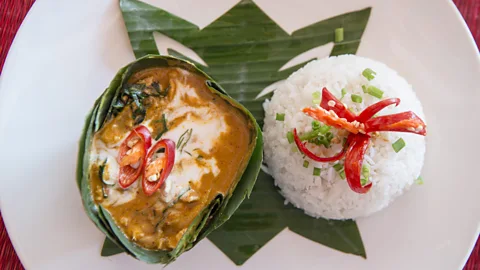Why the humble meat pie defines Australia
 Penny Watson
Penny WatsonEven the tiniest of Australian country towns has at least one bakery, selling everything from the classic steak and pepper to more avant-garde versions like an eggs Benedict pie.
Our coverage during coronavirus
While travelling is on hold due to the coronavirus outbreak, BBC Travel will continue to inform and inspire our readers who want to learn about the world as much as they want to travel there, offering stories that celebrate the people, places and cultures that make this world so wonderfully diverse and amazing.
For travel information and stories specifically related to coronavirus, please read the latest updates from our colleagues at BBC News.
As an Australian school kid, the best day of the week was Friday. It marked the start of the weekend, sure, but it was also “lunch order” day, when, instead of the usual cheese sandwich, we’d get to order from the tuck shop. On this day, we’d forgo our lunch boxes and instead pop a dollar note in a brown paper bag with our order written steadfastly on it:
Penny Watson
Grade 1b
1 meat pie (with sauce please)
Thank you
The bag would then be placed in a basket at the front of the classroom, and returned containing said pie, steaming hot, with tomato sauce oozing from a hole in the top.
If you ever wondered why Australians have such an obsession with the humble meat pie, this inculcation from a very young age is possibly at the heart of it. In heater-less schools built for hot climates despite wintry days, there was nothing quite like the smell and savoury taste sensation found in this warm, mince-filled bakery delight. It came in just the right size for two smallish hands to hold, with a square casing solid enough to retain its shape mid-bite. The pastry on top was wonderfully flaky, but flimsy too, so the tomato sauce nozzle could be poked directly into the pie, mixing sugary tomato sweetness with oozy beefy mince.
 MoMorad/Getty Images
MoMorad/Getty ImagesAnd for most Australians, this pie obsession will happily thrive into adulthood.
You may also be interested in:
• The strange animal roaming Australia
There’s not a wintry weekend that goes by without the idea of a lunchtime pie flicking through my mind. There’s no leftover roast “chook” that doesn’t get me idly perusing a cookbook for the latest chicken pie recipe. There’s not a road trip that doesn’t pit stop for a pie, nor a game of Aussie Rules footy that isn’t bettered by the purchase of a cellophane-wrapped, round Four’n Twenty, a ubiquitous meat pie brand only marginally pipped by Vegemite and pavlova in the iconic food stakes.
I’d go as far as saying that our love for a pie potentially outweighs the fandom it attracts in its country of birth. A British visitor to Australia might declare emphatically that pies are, in fact, classic British pub food. That street vendors in medieval England sold pies as a convenience food for the poor. That expensive, exotic spices such as saffron, ginger and pepper were used in the kitchens of the English nobility to give (and disguise) flavour in pies made from delights such as venison, boar, fish and even peacock. They might explain that 19th-Century English bakers created a pie to feed the masses in celebration of the victory over Napoleon in Waterloo, and that Britain’s literary traditions are riddled and rhymed with characters such as Little Jack Horner who “sat in a corner, eating his Christmas pie” and Georgie Porgie “pudding and pie, kissed the girls and made them cry”.
 Robert CHG/Getty Images
Robert CHG/Getty ImagesIndeed, Australia’s aforementioned most popular pie brand is lifted directly from one of England’s favourite nursery rhymes, Sing a Song of Sixpence, in which “four and twenty blackbirds” were baked into a pie.
I can only apologise for the deaf ears of my fellow countrymen on hearing such rightful claims of cultural ownership. In truth, the roots of our inherited pie obsession might sound slightly less romantic in comparison. Although our love of pies surely originated in Britain, according to The Meat Pie: Australia’s Own Fast Food, an exhibition by Australian Society for History of Engineering and Technology, which toured Australia in 2015 and can now be found online, our pie history began in the early 1800s when the first steam-powered commercial wheat mill opened in Sydney. From then on pie vendors set up on street corners and in bakeries on main streets in every rural town. In the 20th Century, the advent of refrigeration and mass marketing saw the pie transition from humble street snack to big business.
Fast forward to the 21th Century and Australians eat an estimated 270 million meat pies every year – nearly 11 per person annually – according to statistics shared in the exhibition. Even the tiniest of country towns has at least one bakery, selling everything from the classic steak and pepper to more avant-garde versions like an eggs Benedict pie. So, as you might expect, Australia’s Best Pie and Pastie Competition is a massive event down under, and winning is an honour that probably only a true-blue Aussie could understand.
Run by the Baking Association of Australia (BAA), the competition is fierce as hundreds of bakers duke it out to be awarded “the best pie in the country”. Last year, 12 judges were tasked with evaluating 1,794 products from a record 338 bakeries, with a cold and hot pie submitted with each entry.
 Penny Watson
Penny WatsonSome of what they’re looking for in the cold pie, said BAA executive officer Tony Smith, is pastry thickness, shape, filling ratio and “that the pastry is baked out properly but not burnt”. In the hot pie, the top pastry or puff should be light and crispy, “and the filling not too runny or sloppy or too thick or starchy”.
Intriguingly, the back-to-back winners for the past two years, and the first reigning champions in the history of the competition, are Cambodian migrant brothers Chan and Ryan Khun, from Country Cob Bakery in the small town of Kyneton, Victoria.
Their 2018 winning pie was not the ever-popular minced beef pie. Rather, a satay seafood pie, a delicate creamy concoction of crunchy prawn, fish poached in coconut milk, smooth peanut butter and enough curry spice to warm the cheeks.
Judge Mikayla Brightling said the pie was “unbelievable – well created with that smooth satay flavour and seafood cooked to perfection, which is very hard to do in a pie”.
The Kuhn’s 2019 winning entry, a caramelised pork and pepper pie, went a step further and tapped into the pair’s Phnom Penh roots. When I called into the bakery for a taste-test, Chan explained that the recipe is based on caramelised pork with pepper, a staple Cambodian comfort dish that differs slightly with each family recipe. The Khun’s oval-shaped pie has a rich and hearty filling of pork mince combined with tender pork chunks that are slow cooked for three hours to bring out the sweetness. The overriding cracked black pepper notes, reminiscent of the country’s famed Kampot pepper, puts it in the Cambodian culinary category. That it’s in an Australian pie, fit for snacking on straight from the bakery shelf, makes it a fusion first.
 Penny Watson
Penny WatsonIn many ways, Chan and Ryan’s is a typical immigrant story, one where hardship, hard work, entrepreneurial innovation and a hint of good luck have brought success. When Chan left his family in Phnom Penh in 2004 to join his then-wife in Melbourne, he didn’t speak English and had limited translatable skills. He worked night shifts in a factory while studying English during the day, sleeping in his car during lunch breaks.
Chan’s first pie was purchased from a food van parked outside the factory. “It was a beef pie that looked good, but didn’t taste that good,” he said. “Especially to me because I had a different palate and I wasn’t used to it.”
When Chan was serendipitously offered a night shift at a bakery soon after, the idea of making pies to suit the Asian palate started to form in his mind. “I liked the idea of a pie, but the flavours needed to have the salty, sweet and spiciness that Asian people like.”
Success didn’t happen overnight. Chan spent seven years completing his English studies while also gaining accreditation and experience in hospitality, baking and patisserie. In the meantime, Ryan whose Phnom Penh tech business had been seeing hard times, decided, in 2012, to join his family in Australia and study accounting. “Learning English was the hardest part,” Ryan said. “I struggled a lot for at least two years.”
 Penny Watson
Penny WatsonWhen the opportunity for the brothers to buy the Kyneton pie business came about in 2016, they were hesitant. Moving from the Melbourne suburbs to a small country town was not something they had planned. Though Kyneton, 90km north-west of Melbourne’s central business district, has been gentrified with its share of city folk in search of a rural lifestyle, the population could still be described as country conservative.
“We did experience some racism in the first two or three months,” said Chan. “They would write negative things about our pies on Facebook… We had to make the shop the best it could be, and then people started coming and seeing that we were doing good business and that we are bringing tourists to the town.”
The bakery is on a main street, one of a row of heritage buildings in the business end of Kyneton. Chris Cregan, a local who works at the Council Chambers across the road, tells me you can’t walk down the street without somebody asking for directions to “the best pie shop”.
Since taking over, the brothers have knocked through the wall to the neighbouring shop so that customers can peruse 30 different pies – from Thai curry and chilli con carne to butter chicken and garlic prawn – before enjoying it cafe-style at tables and chairs.
 urf/Getty Images
urf/Getty ImagesThey sell between 500 and 800 pies each day, about 20% of which are sold to customers of Asian descent who drive up from Melbourne especially. Looking around the cafe, the order of the day is unfailingly a pie, a flat white coffee and a vanilla slice (another culinary great in this part of the world). “The pork pie is popular,” said Ryan, “but no matter what happens, it can’t compete with the plain meat pies.”
So good is business that the brothers are about to open a second store in Boronia on Melbourne’s eastern fringe. Pivotal to its success will be another win at this year’s pie competition in May. Riding on the coattails of their Cambodian pie success, the brothers are currently trialling a new entry – an amok pie. Anyone who has travelled in Cambodia will have tasted this classic Khmer fish curry laced with lemongrass, coconut milk and chilli. In Cambodia it is served wrapped in banana leaf. In Australia it will be encased in pastry.
I hope it wins. If it does, the tuck shop at my kids’ school might well put it on the menu.
Join more than three million BBC Travel fans by liking us on Facebook, or follow us on Twitter and Instagram.
If you liked this story, sign up for the weekly bbc.com features newsletter called "The Essential List". A handpicked selection of stories from BBC Future, Culture, Worklife and Travel, delivered to your inbox every Friday.
{"image":{"pid":""}}
